Acacias in Chile
Saturday, September 26, 2015, Ian Brown's Blog
In 2012 a small group of us spent a week in Chile at the invitation of INFOR ( Institutio Forestal), the Chilean forest research institute. We were hosted by Juan-Carlos Pinilla, whose responsibilities include research into acacia species. Juan-Carlos is a delightful guy, well informed, and great company. He was a good friend of Ian Nicholas, who led our group, and fulfilled a long term wish to look at acacias in Chile. Tragically this was Ian's last trip, and on the day of his return he experienced the first symptoms of the illness that took his life three months later.
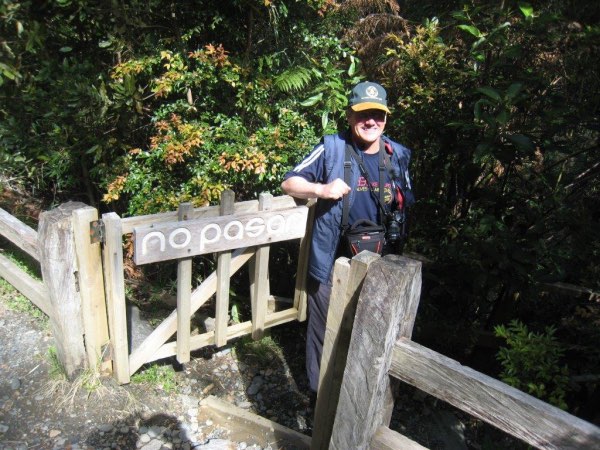 |
| Ian Nicholas |
Acacias were introduced into the Lake District in Southern Chile in the 1950s. The Lake District is a very scenic landscape in the central valley, between the coastal ranges and the Andes. It is good forestry country: the soils are deep, fertile, and free-draining, with average temperature 12.5 degrees, annual rainfall over 2000mm, and little wind.
Exotic forestry in Chile has been based on radiata pine and eucalypt species, following NZ and Australian models. Acacias were introduced to provide some diversity in forest products, A. melanoxylon for decorative timber, A.dealbata for pulp, and A. mearnsii for tannin.
A. melanoxylon.
About 2000 Ha of blackwood have been planted in Chile, and this is expected to increase to 4000 Ha. Sample plots have been established on at least 14 locations. In addition there are sites with natural regeneration, mixed plantings, and shelterbelts.
The current silvicultural regime recommended by INFOR involves close planting at up to 2600 per Ha. The trees are gradually thinned by extraction of 250 trees ( hopefully for pulp) every 7 years, down to a final crop of 350 per Ha. at age 40. Harvest is anticipated at 41 years, with a predicted mean DBH of about 40 cm. Two clearwood prunings will be carried out at age 11 and 16.
Futrono. Blackwood plantation.
Our first exposure to plantation blackwood was at Futrono, on a privately owned woodlot of 6 Ha., one of the 3 best performing sites for blackwood measured among the trial plots in Chile. We expected to see some very good trees, and the best of these were spectacular. There were about 6 to 8 exceptional trees, at age 42, 30 metres tall, and pruned to half their height, DBH in the mid-50s, and perfect form. If Chile can produce trees like this, we have a serious competitor.
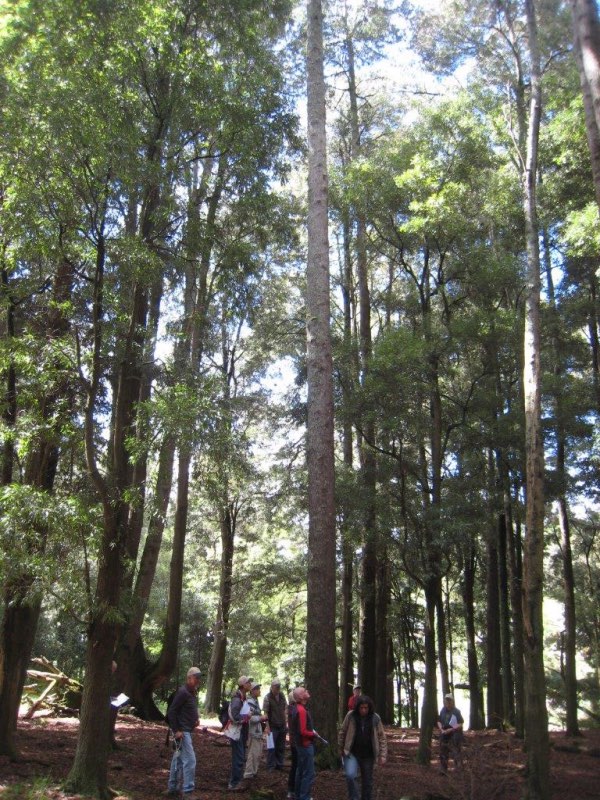 |
| Futrono blackwoods. |
The trees had been planted at high density, about 2600 per Ha. , lightly thinned, and had no form pruning. If the best trees were so good, what of the rest of them? Well, these were much less impressive. At age 40 they were highly stocked at 900 per Ha., with a mean height of 27.5 m., and DBH of just 31.3 cm., and the form was variable. There is a lot of wood in the stand , but I would expect the output of quality sawlogs would be disappointing.
I have a problem with the regime, and will comment on this:
- the aim in close planting is to give a high selection ratio, and to encourage straight growth through competition for light. However it is an expensive option when the stocking is to be reduced in the course of the rotation to a much lower level. Most would regard as the optimal final stocking to be about 200 trees per Ha. The stocking in this stand is far too high, and as a consequence diameter growth will be very slow.
- experience with pure and mixed stands has shown that form pruning is required to limit stem malformation to a minor proportion of trees.
- when thinning is delayed, the live crowns compete for light and retreat, and this has an adverse effect on diameter growth. To prevent this, thinning should be completed early in the rotation ( in my view, within the first 10 years)
- it is expected that the thinned trees will be extracted for pulp. I think the economics of this are very questionable.
- a large volume of data has been collected from the trial plots, and I would question the need for much of this. The sites have been intensively monitored, with measurements of diameter, tree height, and total wood volume. These are appropriate data when assessing most of our exotic plantation species, and even A.dealbata when grown for pulp. However they are unnecessary and even misleading when assessing blackwood, where the value of the tree is likely to be confined to the pruned stem. All we need to know is its height( usually 4 to 6 metres), straightness, and diameter. Above this the crown has no commercial value, and is likely to end up as firewood.
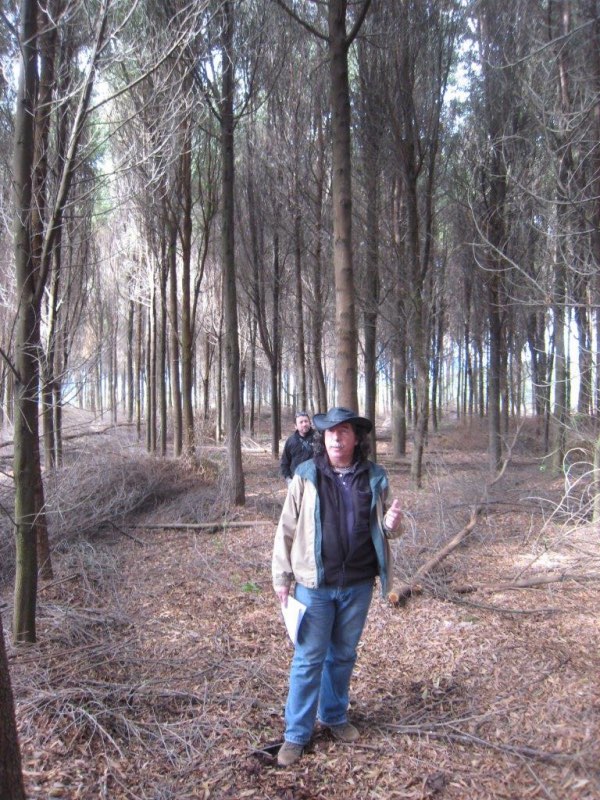 |
| blackwood provenance trial. |
However the crown has real physiological value, in that it determines the volume of wood in the butt log. In blackwood, a tall tree is not a cause for celebration but a sign of trouble. It is an indication of late thinning in the stand, and is linked to slow diameter growth and a very long rotation. In Chile it has been noted, as we have found here, that there is an inverse relationship between the height and diameter of the trees in a blackwood plantation. To prevent this, INFOR have suggested that clearwood pruning should be delayed in support of diameter growth. It seems to me that all this would achieve would be to increase the defect core, and would have no effect on diameter. I think the correct interpretation of the relationship between height and diameter is that it is a consequence of delayed thinning, This causes the crown to retreat, and when this has occurred, it is irreversible.
Other plots
Data were provided for other sites, and ignoring the height and stand volume, three of the better ones are as follows:
Chiloe - at 20 years , mean DBH24 cm.
Arauco - at 28 years, mean DBH 22.5 cm.
Central valley - at 30 years, mean DBH 31 cm.
These figures are not as good as they could be, and I am sure there is a simple explanation. All of these stands are what we would consider to be grossly overstocked. This seems to be due to a misplaced emphasis on total wood volume, at the cost of what really matters, the size and quality of the butt log. However the trip to Futrono showed the real potential for blackwood in Chile.
Lanco. Provenance trial.
A trial incorporating 14 provenances was established in 1999 at Lanco, on a property owned by an expatriate Austrian count. It contained 30 random blocks, at 84 plants per block, at 3 by 2 metre spacing. The provenances were from Tasmania, Victoria, South Australia, and Queensland.
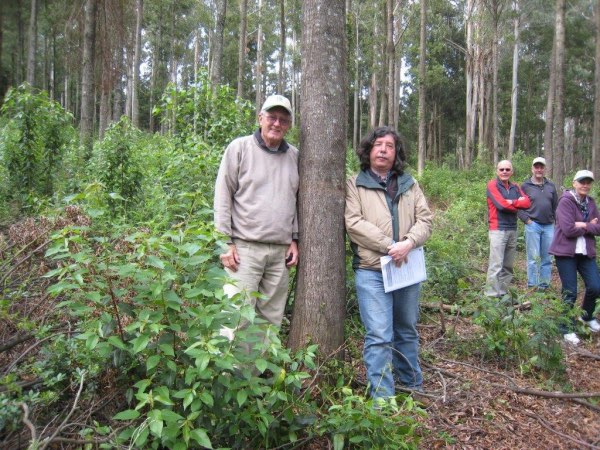 |
| Blackwood plus tree in genetic trial. |
When measured in 2008, the Queensland provenances had very high mortality, and the South Australian trees had poor growth. The best performers were from Tasmania ( King Island, Queenstown, the North-East), and the Otways in Victoria. Interestingly, the provenance from NW Tasmania, where most of our blackwoods were sourced, came further down in the order.
The location appears similar to the sites in northern New Zealand in which blackwoods grow well, so the trial probably has some relevance for us, bearing in mind some limitations: the limited number of provenances, and the lack of data on form, and on wood quality. It matches the data from a 65 provenance trial on my property at Pirongia in the Waikato, which suggests that the provenances best suited to our conditions are in Northern Tasmania, although not necessarily in the North-West.
Quepe. Seed collection
This is a 2.5 Ha. site, in which blackwoods had been interplanted with eucalypts 24 years ago. The eucalypts were felled on one Ha. at 16 years, and the blackwoods that remained were graded for form and vigour, and thinned to 110 per Ha. The best of them were then selected for seed collection as part of a breeding program.
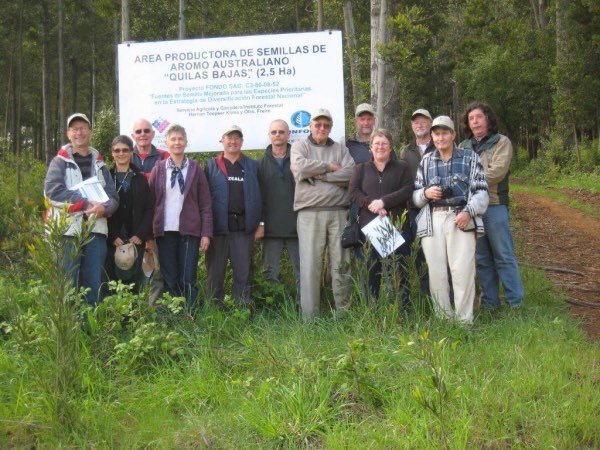 |
| Seed collection site. |
What is now apparent is that many of the trees that were performing less well at age 16 have now caught up with the plus trees. This has been attributed to the need to trim branches in the plus trees for seed collection, but I have some reservations about this. To have this effect, the pruning would have to be very severe. A study in Tasmania has shown that up to 30% of the foliage can be removed from blackwood at one hit without any impact on diameter or height. At 50% there is some effect on diameter. It may be that the "plus trees "had been favoured by a microsite advantage in the original mixture, and now they are on a more level playing field after removing the eucalypts, this effect has been cancelled out.
Another reservation is that the form of the trees, which is generally very good, has been strongly influenced by the adjacent eucalypts, and has had little genetic influence. An assumption that underlies breeding programs that have been carried out in the past for blackwood is that the basic attributes of vigour and form are likely to be inherited. That is certainly true for radiata pine, redwoods, and cypress. However in blackwood , environmental influences, on form in particular, are strongly expressed. Wood colour may be a different matter.
Conclusion.
Before our visit to Chile we had heard stories suggesting that we would see some exceptional blackwoods. After more than a week visiting plantations and viewing trees from the roadside we were left in no doubt that the Lake District in Southern Chile is highly suited for blackwood forestry. It has ideal climate and soils.
Because of its geographical separation from Australia, Chile is also free from acacia psyllids. These pests have been shown to reduce the height growth in young blackwoods by up to 40%. They also contribute to malformation. ( they are not primarily responsible for multi-leadering in blackwood : this is a consequence of growth periodicity, in which the shoots terminate their growth periods by aborting and then replacing the growth tips. The absence of psyllids will make life easier for the grower, but will not eliminate the need for form pruning ).
I am sure the full potential for blackwood could be realised with some adjustments in silvicultural practice. This has been influenced by practices derived from other plantation species, and by a wish to utilise the whole tree. Blackwoods are different. To grow them well we need to abandon the techniques and assumptions that underlie the silviculture of other commercial species. The commercial value of blackwood is likely to be confined to the butt log, and the silvicultural focus should be to grow this as straight and as wide as possible . This requires form pruning, and early and aggressive thinning in the stand. We know from studies in both New Zealand and Tasmania that fast growth in blackwood has no adverse effect on wood quality.
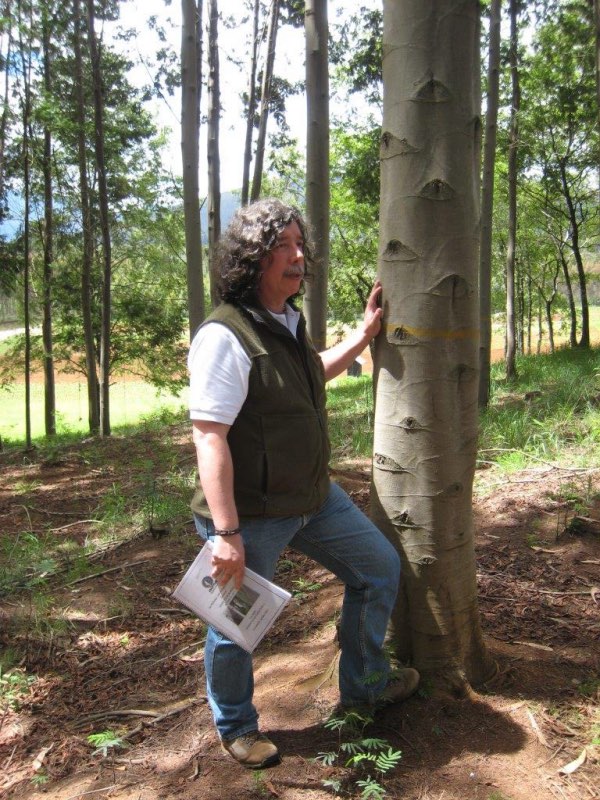 |
| Acacia dealbata trial. |
It will be interesting to follow the tree breeding program in Chile. I think this will be challenging because of the strong impact of the environment on several attributes of blackwood, in particular form, and to a lesser degree vigour. However I am prepared to be proved wrong.
Acacia dealbata
A. dealbata was introduced into Chile for pulp production. Over time its potential uses have expanded to compensate for instability in the pulp market, and the scale of planting has increased. It is now seen as having potential value as decorative timber, perhaps as a source of biofuel, and for rehabilitating degraded soils. We visited research sites.
Loncoche. Progeny trial.
The trial, comprising 1200 trees, was established in 1999. 6 progenies were tested, from Tasmania and NSW.
At the time of establishment the end use was considered to be centred on pulp production, so the focus was on volume, and measurements were limited to height and diameter.
The most productive provenance was from Snug, in the Huon valley, south of Hobart. Only 7 provenances were tested, and future trials will cast the net further with additional provenances, and collection of data such as stem form that are relevant to sawlog production.
Of concern was high natural mortality, averaging 65% at age 8, and increasing by 12% between age 6 and 8.
Canete. Genetic, pruning and thinning trials.
This site is one of several trials designed to assess the effect of different thinning and pruning regimes. Trees were planted at 1600 per Ha., thinned at two different intensities at age 3 and 5, and pruned to 4 metres.
- growth rate in height and diameter was rapid, matching radiata pine and eucalypts at 6 years. Average diameter was approaching 20 cm at age 6.
- as expected, the trees that were more widely spaced showed greater diameter and height, and about the same overall volume per Ha. as those that were lightly thinned.
- the best trees were impressive, but there was a lot of malformation in the stand, and evidence of continuing mortality.
- the trees are being considered for a short rotation, perhaps at age 15.
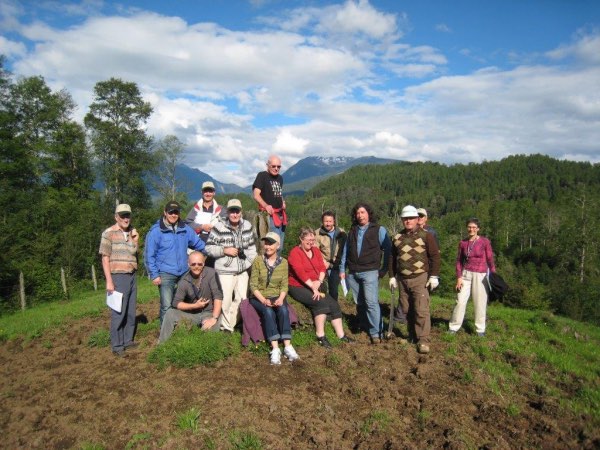 |
| The group |
The trials are preliminary, and will be interesting to follow. It will also be of interest to follow the level of natural mortality, and the possible influence of fast growth on wood quality. In A. melanoxylon, fast growth does not compromise wood quality. Whether that applies to A. dealbata remains to be seen.
If grown for sawlogs, pruning will need to carried out on time to restrict the defect core and prevent dead knots. In A. dealbata the lower branches die back early, and the resultant knots are black and unstable.
El Carmen. Biomass trial.
A. dealbata is under consideration for biomass production because of its rapid growth, suitability for short rotations, and ability to thrive on poor sites.
Trees were planted on this site at a range of spacing, up to 40,000 per Ha. (1/2 metres apart), making visual assessment challenging, and data are very preliminary. Biomass productivity is certainly high, but there might be potential problems:
- designing a method of harvesting.
- controlling seedling regeneration. The trial is designed to identify the optimal planting density. After harvesting, massive regeneration can be expected over several years from ground-stored seeds, This will interfere with the subsequent planting regime, and could sabotage possible future genetic gains.
- possible effects on soil.
- fire risk.
- uncertainties regarding economics.
Acacias as potential weeds.
Both A. melanoxylon and A. dealbata are common along roadside margins, raising the question: might they become weeds? A. melanoxylon can be spread by birds in Australia and South Africa, although this does not occur in New Zealand. (although where present they are likely to be persistent because of long seed viability in the soil). In Chile the locals do not seem concerned, but time will tell.
A. dealbata is a more aggressive coloniser, and we saw a good example adjacent to a strip of recently formed road. There had been a fire, and the ground extending for some distance from the road was covered with a mass of A. dealbata seedlings.
After discussion with our guides, it became apparent that these were the third generation in a process of colonisation. The first generation were a small group of trees located in a high valley over 100 Km. away. Their seeds had washed downstream, lodging among stones on the river bank. The stones were later excavated by a road gang, and transported for use in road construction. In the process the seeds were scarified, and thereby inadvertently prepared for germination. The second generation grew from seeds scattered on the road margin during road construction. We were looking at the third generation, which appeared a few years later. The cause was a fire, perhaps lit from a cigarette thrown from a passing car. Within a few years this will be a forest, ready to spread further after the next disturbance.
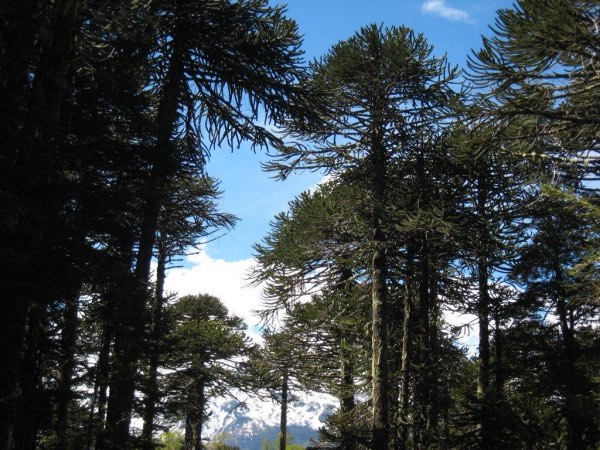 |
| Araucarias |
A. mearnsii
A. mearnsii has been grown in Brazil and Mexico since the 1930s for production of tannins. Both the volume and quality of tannins in the bark of A. mearnsii are high.
Valdivia. Progeny trial.
The trial was established in 1995. 10 provenances were tested, from NSW and Tasmania. The best performers are from NSW. 3 plus trees have been selected for form and volume, and will be included in a genetic improvement program.
It is expected that trees will be harvested for study at 8 years.
The current market for tannin is uncertain, partly because of the introduction of alternative products. To compensate for this, A. mearnsii has been considered for pulp production, but here there are problems: the pulp is of lower quality than A. dealbata, and is difficult to manage, requiring a special mill.
Interest in A. mearnsii in Chile appears to be diminishing. At the same time interest in A. dealbata in Chile is increasing, in recognition of its rapid growth, and potential value as a decorative timber.
Native species.
Two of the native species were of particular interest. These were native beech, and Araucaria.
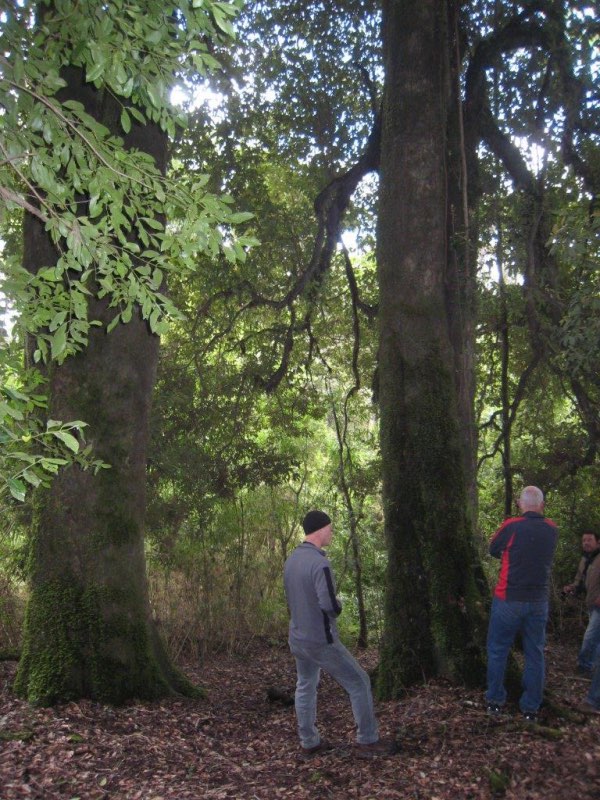 |
| Beech |
Nothofagus.
Of the beech species endemic to Chile, two are receiving special attention. These are N. obliqua ( roble), and N. alpina (rauli). Both were formerly widespread in the Central Valley, rauil occupying more elevated sites, but were reduced to remnants by milling, and the land was converted to farms.
They share some common features. They are deciduous, can sprout from the base after milling, grow to 50 metres and with large diameters, and produce high quality timbers. From some second growth trees that we looked at, they grow at a very respectable rate.
We visited one of more than 10 trial sites. INFOR have a very active research program, looking at genetic improvement and thinning and spacing regimes. They are paying close attention to matching provenance to site. ( Climate change might get in the way of that).
Araucaria
From the Central Valley the eastern skyline is dominated by a string of volcanoes. One of them, the Llaima volcano, over 3000 metres high and intermittently active, is located in the Parque Nacional Conguillio. As we approached the park, the first of the Araucarias came into view along the high ridgelines, and became more prevalent as we approached the volcano.
These are unique and magnificent trees, flat-topped and growing to over 40 metres, and 2 to 3 metres in diameter. They thrive in a hostile environment, tolerating extreme cold at high altitude, on free-draining but nutrient-poor soils. Growth is slow - 40 year old trees were a few metres tall, but time is not an issue. These trees live up to 2000 years, about the same age as kauri. Their timber is apparently very good, but they are of course now protected, and their seeds can only be taken by local Mapuche people, for whom the trees are sacred.
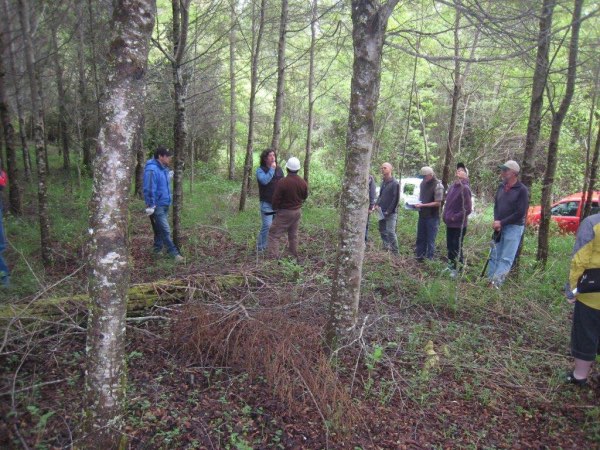 |
| Beech trial |
Connections
Over many years, Ian Nicholas developed strong connections with fellow researchers offshore. In the blackwood community this includes scientists in Australia, South Africa, Chile, and more recently China. Now that he is no longer with us, it is important that we maintain those linkages. We have had a head start on the Chileans, but they have made a lot of progress in a short time, and it is to our mutual benefit that we keep in touch.
Disclaimer: Personal views expressed in this blog are those of the writers and do not necessarily represent those of the NZ Farm Forestry Association.

 Farm Forestry New Zealand
Farm Forestry New Zealand
No posts yet
Add a post